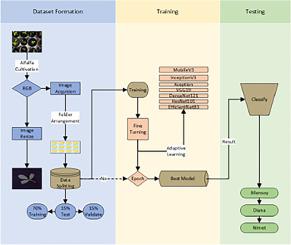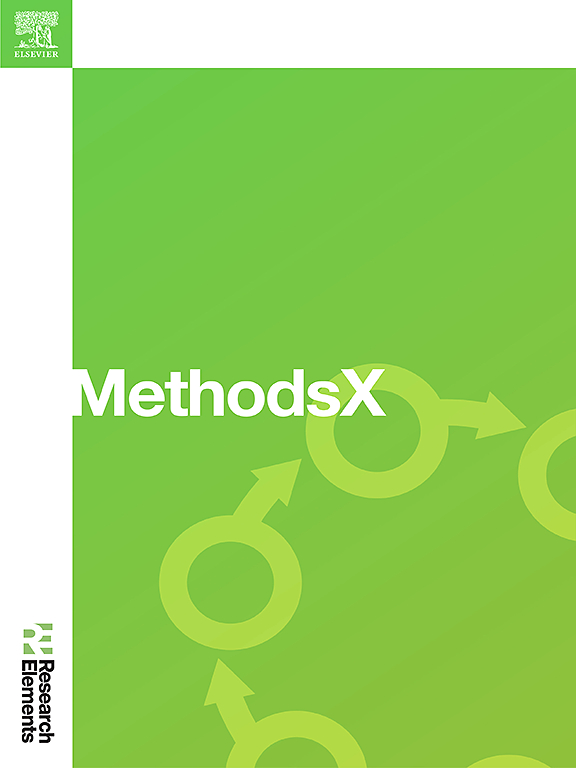基于深度学习的紫花苜蓿品种分类:使用自定义叶片图像数据集进行比较研究
IF 1.6
Q2 MULTIDISCIPLINARY SCIENCES
引用次数: 0
摘要
深度学习通过提高植物分类任务的准确性和效率,对农业产生了深远影响。特别是,先进的模型大大提高了根据视觉特征对各种植物物种进行分类的能力。本研究的重点是利用深度学习技术对紫花苜蓿植物品种进行分类。我们创建了一个自定义数据集,其中包括在受控条件下栽培的三个紫花苜蓿品种(Bilensoy-80、Diana 和 Nimet)的 1,214 张图像。我们的比较研究涉及多个最先进的模型,包括 MobileNetV3、InceptionV3、Xception、VGG19、DenseNet121、ResNet101 和 EfficientNetB3,以评估它们在对这些紫花苜蓿品种进行分类时的性能。我们用不同的配置对这些模型进行了评估:学习率从 0.1 到 0.000001 不等;批量大小为 8、16、32 和 64;使用衰减率为 0.96、衰减步数为 1000 的 dropout。结果显示,使用迁移学习训练的模型通常能获得更高的测试准确率。例如,DenseNet121 从零开始训练时的测试准确率为 0.9945,而采用迁移学习后的测试准确率为 1.0000,而 EfficientNetB3 采用这两种方法后的测试准确率均为 0.9945。研究引入了一个独特的数据集,该数据集由在受控条件下栽培的三个紫花苜蓿品种(Bilensoy-80、Diana 和 Nimet)的 1214 张图像组成,为推进植物分类研究提供了宝贵的资源。-该研究比较了几种最先进的深度学习模型(MobileNetV3、InceptionV3、Xception、VGG19、DenseNet121、ResNet101 和 EfficientNetB3)在不同超参数配置下的性能,展示了不同架构在紫花苜蓿植物品种分类中的有效性。本文章由计算机程序翻译,如有差异,请以英文原文为准。

Deep learning-based classification of alfalfa varieties: A comparative study using a custom leaf image dataset
Deep learning has profoundly impacted agriculture by enhancing the accuracy and efficiency of plant classification tasks. In particular, advanced models have significantly improved the ability to classify various plant species based on their visual features. This study focuses on classifying alfalfa plant varieties using deep learning techniques. We created a custom dataset comprising 1,214 images of three alfalfa varieties (Bilensoy-80, Diana and Nimet) cultivated under controlled conditions. Our comparative study involved several state-of-the-art models, including MobileNetV3, InceptionV3, Xception, VGG19, DenseNet121, ResNet101, and EfficientNetB3, to assess their performance in classifying these alfalfa varieties. We evaluated these models with various configurations: learning rates ranging from 0.1 to 0.000001, batch sizes of 8, 16, 32, and 64, and using dropout with a decay rate of 0.96 and decay steps of 1000. The results revealed that models trained with transfer learning generally achieved higher test accuracies. For instance, DenseNet121 achieved a test accuracy of 0.9945 when trained from scratch and 1.0000 with transfer learning, while EfficientNetB3 achieved a test accuracy of 0.9945 with both methods. The findings underscore the effectiveness of transfer learning in enhancing model performance for plant classification tasks.
- •The study introduced a unique dataset consisting of 1214 images of three alfalfa varieties (Bilensoy-80, Diana, and Nimet) cultivated under controlled conditions, providing a valuable resource for advancing plant classification research.
- •The research compared the performance of several state-of-the-art deep learning models (MobileNetV3, InceptionV3, Xception, VGG19, DenseNet121, ResNet101, and EfficientNetB3) with various hyperparameter configurations, demonstrating the effectiveness of different architectures for classifying alfalfa plant varieties.
- •The study highlighted the superior performance of transfer learning in plant classification tasks, with models like DenseNet121 and EfficientNetB3 achieving near-perfect accuracy, underscoring its potential to significantly enhance model accuracy and efficiency in agricultural applications.
求助全文
通过发布文献求助,成功后即可免费获取论文全文。
去求助
来源期刊

MethodsX
Health Professions-Medical Laboratory Technology
CiteScore
3.60
自引率
5.30%
发文量
314
审稿时长
7 weeks
期刊介绍:
 求助内容:
求助内容: 应助结果提醒方式:
应助结果提醒方式:


